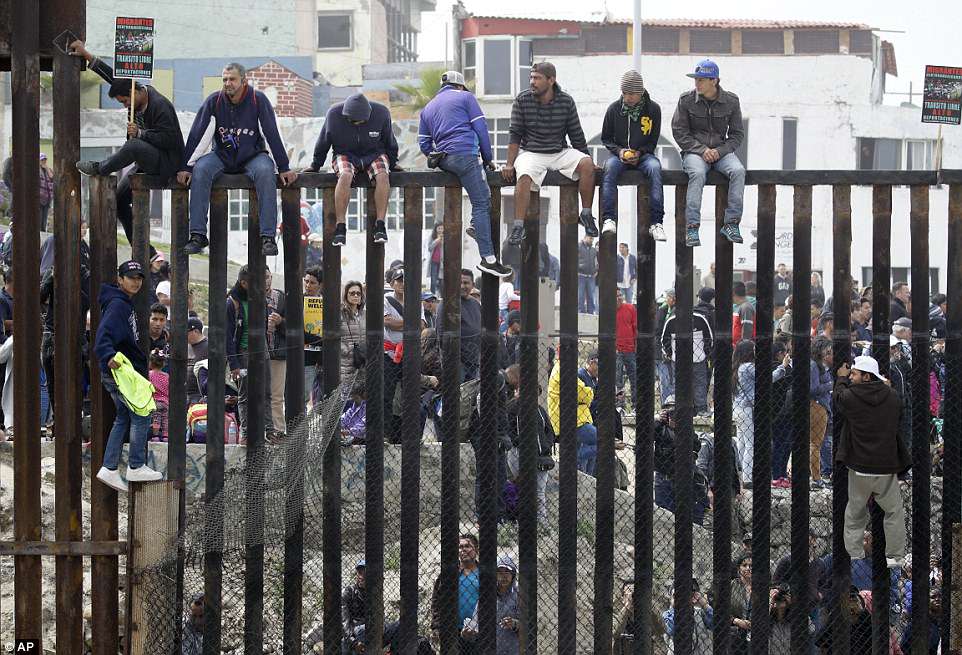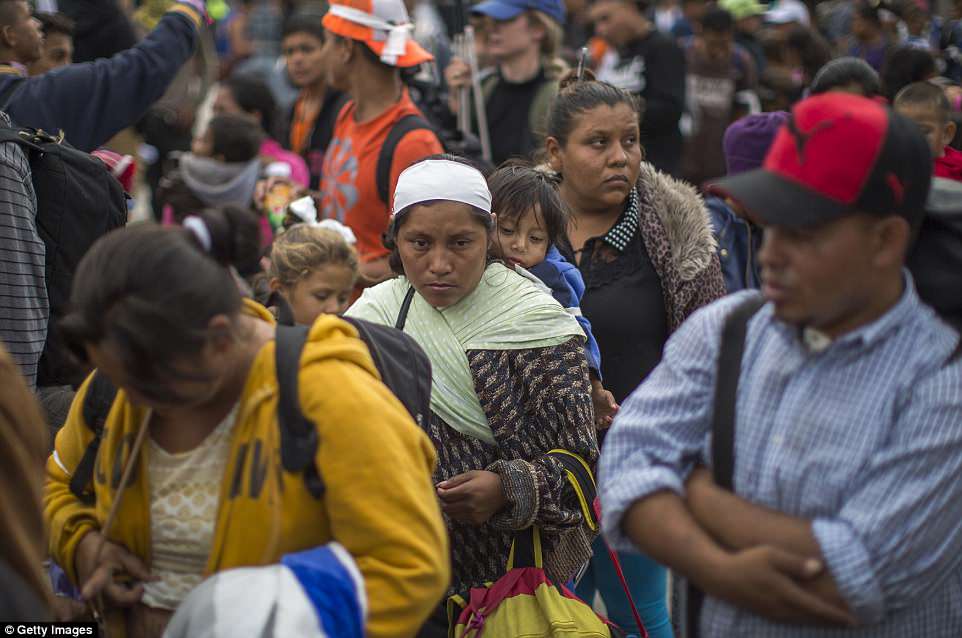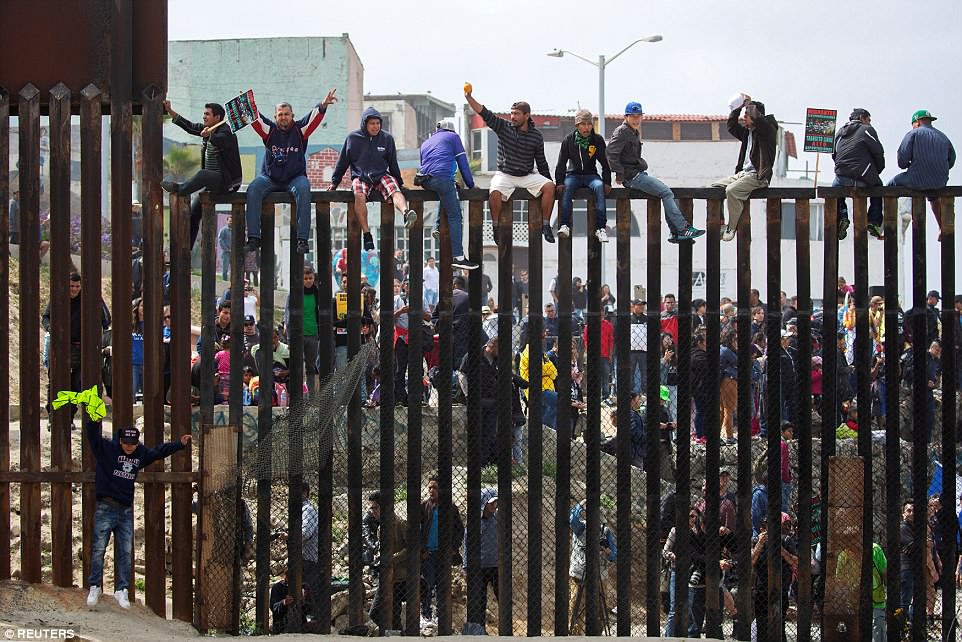Nearly 200 Central American migrants attempting to seek asylum in the United States were stopped in their tracks when border inspectors said that a crossing facility didn’t have enough space to accommodate them.
They travelled through Mexico in five old school buses with great fanfare for a month under the Trump administration’s watchful eye, claiming they had a fear of persecution at home.
Trump vowed last week to ‘stop’ the caravan while Cabinet members said they would deliver a swift response. The asylum seekers held firm, setting up a possible showdown.
In an anticlimactic twist, about 50 asylum seekers were allowed past a gate controlled by Mexican officials to walk across a long bridge but were stopped at the entrance to the U.S. inspection facility at the other end.
They were allowed to wait outside the building, technically on Mexican soil, without the word of when U.S. officials would let them claim asylum.
Pictures showed some migrants trying to scale the border fence to reach the U.S. as well as videos that show them shouting ‘Gracias, México!’ as they managed to make the journey over.

A girl and other members of a caravan of migrants from Central America get ready to spend the night near the San Ysidro checkpoint after a small group of fellow migrants entered the United States border and customs facility

Around 50 or so camped on blankets and backpacks in Tijuana outside the Mexican side of the crossing, prohibited from even getting close to the U.S. inspection building

Officials had warned that San Diego’s San Ysidro crossing may not be able to take asylum seekers if it faces too many at once

U.S. immigration lawyers had warned the migrants of the low odds for winning asylum and the likelihood of detention, separation from relatives and deportation
According to the Los Angeles Times, several of the migrants from the caravan have crossed into the U.S. illegally.
The paper reported that pregnant women and a few children entered the U.S. through a canyon that authorities described in a statement as dark, treacherous and ‘notorious for human and drug smuggling’.
Another 50 or so camped on blankets and backpacks in Tijuana outside the Mexican side of the crossing, prohibited from even getting close to the U.S. inspection building.
Police with flashing lights escorted the buses to a cross-border rally at a Pacific Ocean beach, with supporters gathering on both sides of security fencing brandishing signs.
About 50 supporters watched on the US side where they have held about 20 yards away.
The mood was sombre following a gruelling 2,000-mile trek to the border.
U.S. immigration lawyers had warned the migrants of the low odds for winning asylum and the likelihood of detention, separation from relatives and deportation.
‘I’m nervous. I’m afraid,’ said Linda Sonigo, 40, walking solemnly toward the U.S. gate with her two-year-old granddaughter in her arms. ‘I’m afraid they’ll separate us,’ she said, motioning to her two children and grandchild.

A statement on Sunday from US Customs and Border Protection says the nation’s busiest border crossing can take in additional people as space and resources become available

US officials say San Diego’s border crossing has reached capacity even before a caravan of Central American migrants criticized by the Trump administration began turning themselves in to seek asylum

U.S. officials do not usually separate children from parents seeking asylum, although immigration advocates have reported instances of it happening. Families often spend less time in detention than other groups

The arrival at San Diego’s San Ysidro border crossing marked the end of a month-long journey by foot, freight train and bus for the migrants – many of whom said they feared for their safety in their homes
U.S. officials do not usually separate children from parents seeking asylum, although immigration advocates have reported instances of it happening. Families often spend less time in detention than other groups.
Asked how he felt as he boarded the bus, Nefi Hernandez of Honduras replied: ‘Nervous.’ He said he intended to seek asylum with his wife and infant daughter, who was born on the journey through Mexico.
The arrival at San Diego’s San Ysidro border crossing marked the end of a month-long journey by foot, freight train and bus for the migrants – many of whom said they feared for their safety in their homes.
At one point in early April, the caravan gathered 1,500 immigrants from Honduras, Guatemala and El Salvador.
It has drawn the wrath of Trump, who ordered immigration officials to be zealous in enforcing rules to stop unlawful entry by caravan members.
More migrants from the caravan, which numbered around 400 people by the time it reached Tijuana, also planned to seek asylum.

Members of a caravan of migrants from Central America hug as the first group is allowed to enter the United States border and customs facility

Members of a caravan of migrants from Central America walk towards the United States border and customs facility, where they are expected to apply for asylum, in Tijuana, Mexico

At one point in early April, the caravan gathered 1,500 immigrants from Honduras, Guatemala and El Salvador

Central American migrants traveling in the ‘Migrant Via Crucis’ caravan say goodbye to their relatives, before entering El Chaparral border crossing in Tijuana

Migrants said they planned to camp outside, sleeping in shifts, until every member of the caravan has been processed

Members of a caravan of migrants from Central America get ready to spend the night near the San Ysidro checkpoint after a small group of fellow migrants entered the United States border and customs facility

About 100 set up an open-air camp in a small square on the Mexican side by the San Ysidro pedestrian bridge, saying they would stay there until they were allowed through. With no shelter, they laid out towels and blankets on the cold concrete

Members of a caravan of migrants from Central America walk towards the United States border and customs facility, where they are expected to apply for asylum

More than a dozen asylum seekers climbed the fence separating San Diego and Tijuana as part of a rally on Sunday before they seek asylum in the US
About 100 set up an open-air camp in a small square on the Mexican side by the San Ysidro pedestrian bridge, saying they would stay there until they were allowed through.
With no shelter, they laid out towels and blankets on the cold concrete.
Hernandez, 24, said a gang in his hometown of San Pedro Sula, Honduras, threatened to kill him and his family if he did not sell drugs.
Jose Cazares, 31, said he faced death threats in the Honduran city of York because a gang member suspected of killing the mother of his children learned one of his Cazares’ sons reported the crime to police.
But the travelers faced an uncertain future as they prepared to turn themselves in and face asylum.
US immigration lawyers conducted free legal workshops for the group, warning them they face possible separation from their children and detention for many months.

US immigration lawyers conducted free legal workshops for the group, warning them they face possible separation from their children and detention for many months

The remnants of a caravan of Central Americans that journeyed across Mexico to ask for asylum in the United States, have reached the border to apply for legal entry

It has drawn the wrath of Trump, who ordered immigration officials to be zealous in enforcing rules to stop unlawful entry by caravan members

Trump vowed last week to ‘stop’ the caravan while Cabinet members said they would deliver a swift response. The asylum seekers held firm, setting up a possible showdown

They were allowed to wait outside the building, technically on Mexican soil, without a word of when U.S. officials would let them claim asylum

U.S. Customs and Border Protection Commissioner Kevin McAleenan announced that the San Ysidro border crossing, the nation’s busiest, had ‘reached capacity’ for people without legal documents

Attorney General Jeff Sessions has called the caravan ‘a deliberate attempt to undermine our laws and overwhelm our system’

Homeland Security Secretary Kirstjen Nielsen said asylum claims will be resolved ‘efficiently and expeditiously’ and warned that anyone making false claims could be prosecuted

The San Ysidro border inspection facility can hold about 300 people, according to Pete Flores, Customs, and Border Protection’s San Diego field office director, suggesting the bottleneck may be short-lived

The US has threatened to arrest around 100 Central American migrants if they try to sneak in from the US-Mexico border where they have gathered, prompting President Donald Trump to order troop reinforcements on the frontier

Central Americans who traveled with a caravan of migrants walk towards the border yo request asylum in the United States
The asylum-seekers began the day with anticipation, traveling in red-and-white school buses under police escort to a beachfront rally in Tijuana, where a steel fence juts out into the Pacific Ocean.
They sang the Honduran national anthem, and supporters on the San Diego side of the fence waved a Honduran flag.
After a final briefing from lawyers and minutes before they were to begin a short walk to the border crossing, U.S. Customs and Border Protection Commissioner Kevin McAleenan announced that the San Ysidro border crossing, the nation’s busiest, had ‘reached capacity’ for people without legal documents and that asylum-seekers may need to wait in Mexico temporarily.
‘We have reached capacity at the San Ysidro port of entry,’ McAleenan in a statement on Sunday, adding that the immigrants ‘may need to wait in Mexico.’
Trump has commented frequently on the caravan since it started in Mexico on March 25 near the Guatemala border and headed north to Tijuana.
His broadsides came as his administration vowed to end what officials call ‘legal loopholes’ and ‘catch-and-release’ policies that allow people requesting asylum to be released from custody into the U.S. while their claims make their way through the courts, which can take years.
Attorney General Jeff Sessions has called the caravan ‘a deliberate attempt to undermine our laws and overwhelm our system.’
Homeland Security Secretary Kirstjen Nielsen said asylum claims will be resolved ‘efficiently and expeditiously’ and warned that anyone making false claims could be prosecuted.

Members of a caravan of migrants from Central America wait to enter the United States border and customs facility on Sunday

The asylum seekers climbed the border fence under the watchful eyes of US Border Patrol agents
She warned that any asylum seekers making false claims to US authorities could be prosecuted, as could anyone who assists or coaches immigrants on making false claims.
The administration’s stern warnings left organizers in disbelief that border inspectors were not ready for them.
‘They have been well aware that a caravan is going to arrive at the border,’ Nicole Ramos, an attorney working on behalf of caravan members, said at a news conference.
‘The failure to prepare and failure to get sufficient agents and resources is not the fault of the most vulnerable among us. We can build a base in Iraq in under a week. We can’t process 200 refugees. I don’t believe it.’
The San Ysidro border inspection facility can hold about 300 people, according to Pete Flores, Customs and Border Protection’s San Diego field office director, suggesting the bottleneck may be short-lived.
The agency processed about 8,000 asylum cases from October through February, or about 50 a day.
Administration officials and their allies claim that asylum fraud is growing and that many who seek it are coached on how to do so.
Asylum-seekers are typically held for up to three days at the border and then turned over to U.S. Immigration and Customs Enforcement.
If they pass an asylum officer’s initial screening, they may be detained or released into the U.S. with ankle monitors.

A member of the Central American migrant caravan looks through the border wall toward a group of people gathered on the US side on Sunday

The migrants, many traveling with children, left a downtown Tijuana shelter earlier on Sunday where they had been staying

Police with flashing lights escorted the buses filled with migrants to a cross-border rally at a Pacific Ocean beach

Central American migrants demonstrate at the US-Mexico border at Tijuana’s beaches on Sunday
Asylum seekers didn’t appear to be thrown off the by the delay.
Wendi Yaneri Garcia said she was confident she will be released while her asylum case is pending because she is traveling alone with her two-year-old son, who has been sick.
She said that police in her hometown of Atlantida, Honduras, jailed her for protesting construction of a hydroelectric plant and that she received death threats after being released.
‘All I want is a place where I can work and raise my son,’ the 36-year-old said.
Maria de Los Angeles, 17, also said she felt confident after speaking with an attorney that US authorities would release while her case wends its way through court because she was traveling alone with her one-year-old son.

Members of the human caravan that has traveled through Mexico to the American border started climbing the 18-foot high fence that separates the two countries on Sunday

A group of members of a migrant caravan looks through the US-Mexico border wall before they plan to make an asylum request

Those who climbed the border fence cheered and brandished signs as part of the asylum rally
She hoped to move in with a sister in San Francisco. She said she fled her home in Jutiapa, Honduras because the father of her son threatened to kill her and their child.
‘I’m fired up to go because I believe in God and I believe everything will work out,’ she said.
Elin Orellana, a 23-year-old pregnant woman from El Salvador, said she is fleeing the violent MS-13 street gang, a favorite target of both Sessions and Trump because of their brutal killings in communities in the United States.
She said her older sister had been killed by the gang in El Salvador, so she is attempting to join other family members in the Kansas City area.
‘Fighting on is worth it,’ she said as she camped out for a chilly night outside the border crossing.

The arrival at San Diego’s San Ysidro border crossing, the nation’s busiest, marked the end of a month-long journey by foot, freight train and bus for the migrants

US Border Patrol Agents watch protesters on the US side of the border during the rally on Sunday

A group of supporters who walked from Los Angeles march toward the US-Mexico border wall on Sunday to greet refugees from the caravan
If you know someone who might like this, please click “Share!”
